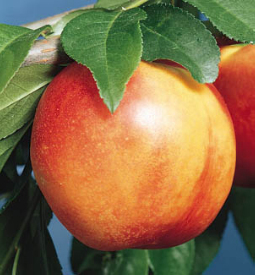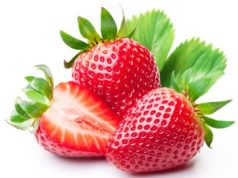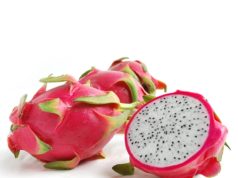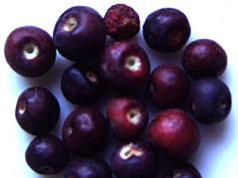 Nectarines [Prunus persica (L.) Batsch, var. nectarina] belong to the Rosaceae family and are thought to have originated in China. Chinese literature dates its cultivation in China to 1000 B.C. and it was probably carried from China to Persia.
Nectarines [Prunus persica (L.) Batsch, var. nectarina] belong to the Rosaceae family and are thought to have originated in China. Chinese literature dates its cultivation in China to 1000 B.C. and it was probably carried from China to Persia.
Nectarine fruit also has been described as fuzz less peach, or as a mutation of a peach that may mutate back to a nectarine and then again mutate back to the peach.
Even though the word ‘nectarine’ was first used in England in 1616, there is no conclusive evidence that the usage of the word derived from the Greek word meaning nectar.
Currently, world production of peaches and nectarines stands at 11 million tonnes, with the three major producing countries being China, Italy and the United States in the Northern hemisphere and Chile.
The nectarine has been known and described for nearly as long as the peach. Most of the world’s peach-growing areas have also introduced nectarine cultivars. Nectarines can be used in the same way as peaches, and may be considered as better substitute for peaches.
Genetically, the only difference between peaches and nectarines is the lack of fuzz on the nectarine skin. Usually, nectarines are smaller than peaches and have more redder colour on the surface, and more aroma.
Nectarine colours are brighter than those seen in peaches, because the fuzz on the peach tends to dilute the bright colour of the skin below.
Popular uses for nectarines include fresh eating, sugared, and with cream. It can also be used in ice cream, pies, cobbler, and shortcake. In addition, nectarines are used for jam, jelly, preserves, and mixed fruit desserts.
Fresh nectarines provide twice the vitamin A, slightly more vitamin C, and much more potassium and fibre than peaches. They are low in saturated fats, cholesterol and sodium. One ripe nectarine (75g) provides 5.5g of carbohydrates, 2g of fibers, 0g of fats and in all 115 kilojoules of energy. The seed contains high levels of hydrogen cyanide.
In small quantities, hydrogen cyanide has been shown to stimulate respiration and improve digestion, it is also claimed to be of benefit in the treatment of cancer.
On the basis of the separation of the stone from the flesh, nectarines can be divided into two groups: freestone and clingstone. In addition, based on the amount of softening of the flesh that occurs during ripening, nectarines can be either of a melting or non-melting type.
Melting fruit will soften to below 8N firmness, while non-melting fleshed fruit will soften to 16N or higher. Nectarines may be either yellow or white-fleshed. Colour varies according to cultivar. Green colour indicates immaturity.
The nectarine fruit is most often eaten with the tender skin on it, and it ripens mostly in June through September. However nectarine can be judged ripe, when it is fragrant and soft to the touch on the tree.
Cultivation
Site with a high elevation so that cold air can drain away from the tree on a cold night during bloom is best suited for nectarine cultivation. Nectarines require full sunlight and should not receive shade from buildings or tall trees.
Soil texture should be well drained and sandy loam type. Nectarine tree roots or rootstocks are sensitive to water logging so well drained soils are to be preferred.
[indeed-social-locker sm_list=’fb,tw,go1′ sm_template=’ism_template_1′ sm_list_align=’horizontal’ sm_display_counts=’false’ sm_display_full_name=’true’ locker_template=2 sm_d_text='<h2>This premium content is locked</h2><p>Share This Page To Unlock The Content!</p>’ ism_overlock=’default’ ]
In Jammu and Kashmir nectarines were introduced for the first time from state of Himachal Pradesh at Regional Horticulture Research Sub Station- Bhaderwah, SKUAST-Jammu during 2006-07. Fruiting is taken for the first time at this research station and SKUAST-Jammu is all set to spread cultivation technology to interested farmers. Planting material is also available at this research station. Nectarine varieties cultivated and for which planting material available at RHRSS-Bhaderwah, SKUAST-Jammu is Snow Queen, Silver King, Fantasia, Independence, Red Gold and May Fair.
Nectarines can be successfully introduced in our state at most of the places with temperate climate.
Planting
In Jammu region planting could be done with the onset of spring .Keep the bud union one inch above the soil. Plant budded plants at a distance of 4m x 4m. Planting nectarine plant too deep in the soil can cause poor growth or death.
Fruit starts bearing in second year itself but it should be avoided in order to maintain proper plant vigour. Fruit should be allowed to set third year onwards depending on plant health. In fourth year, on an average plant yields 8-10kgs of fruit.
Training and Pruning
The open centre system is recommended for nectarine trees for maximum sunlight exposure, maximum yield, and best quality. Pruning and training is done in the year of planting and every year after. Immediately after planting, pruning is done to keep the tree back to a height of 26 to 30 inches.
All side branches are cut off to leave a shoot without lateral branches .This sounds drastic; however, the best shaped open centre trees come from those pruned initially to a whip.
During the first year, diseased, broken, and low-hanging limbs are removed. During the second and third years, remove low-hanging, broken, and/or diseased limbs.
To maintain the open vase, remove any vigorous upright shoots developing on the inside of the tree, leaving the smaller shoots for fruit production. Finally, prune the vigorous upright limbs on the scaffolds by cutting them back to an outward growing shoot.
Harvesting
Harvest date is determined by skin ground colour changes from green to yellow and then red in most cultivars. Nectarines ripen and deteriorate quickly at ambient temperature. Therefore, cold storage is used to slow these processes and decay development.
Measurement of fruit firmness is recommended in cultivars where skin ground colour is masked by full red colour development before maturation. Since nectarines are a climacteric fruit, they are harvested when they reach a minimum or higher maturity, but are not completely ripe (“ready to eat”). Initiation of the ripening process must occur before consumption to satisfy consumers.
Most consumers will be satisfied after eating ripe nectarines, however, when consumers eat even high quality but unripe fruit, they will not be satisfied.
Nectarines need thinning approximately three to four weeks after bloom; fruits should be removed by hand so that the remaining fruits are spaced about every 8 inches. Fruit thinning allows the remaining fruits to develop optimum size, shape, and colour, and prevent depletion of the tree.
Nectarines are mulched and/or irrigated as needed. Irrigation increases yield particularly if it is applied three weeks before harvest.
Nectarines need proper pest management programme. Some of the common insects and mites that affect nectarines are tarnished plant bug, stink bug, oriental fruit moth, plum curculio, tree borers, Japanese beetle, green June beetle, and European red mite. Common nectarine diseases are leaf curl, brown rot, leaf shot hole, scab, bacterial spot and powdery mildew.
Contributed By:
Dr. Brajeshwar Singh, Dr. R. M. Sharma and Dr. J.N. Srivastava
Scientists, RHRSS-Bhaderwah, SKUAST-Jammu
[/indeed-social-locker]








